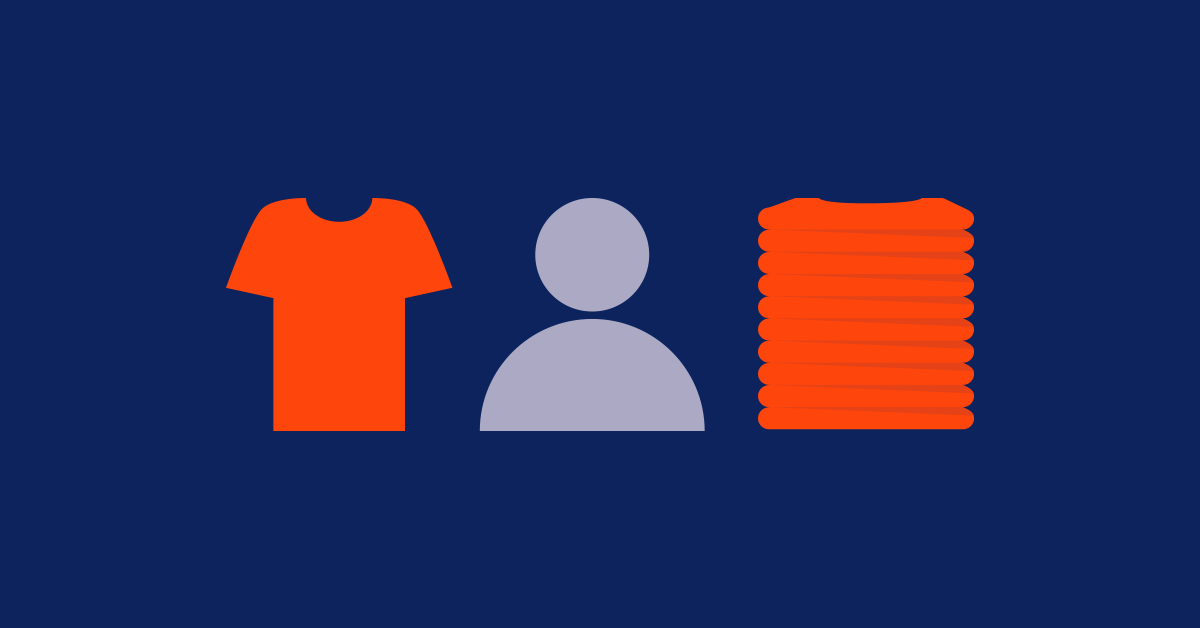
Having too much stock on hand is a financial burden on your retail business. Slow sales means less ability to cycle in newer inventory that does land with your customers, because your revenue is tied up in inventory that isn’t going anywhere.
Just as bad, though, is having not enough stock on hand. If you can’t fill the demand, a competitor can, and so you’ll have lost potential sales.
With accurate demand forecasting, however, you can ensure you always have just enough stock. Luckily, getting started with inventory forecasting isn’t hard—as long as you’re working with a point of sale system that helps you track and measure data.
In this post, we’ll go over:
- Qualitative vs. quantitative inventory forecasting
- Best practices to perfect your inventory forecasting
- The perks of inventory forecasting software
Let’s get started!
Reinvent your business for short and long-term success
Retail owners and operators face a whole new set of challenges. Download our free playbook and learn how to diversify sales and build a more resilient business post-pandemic.
Demand forecasting methods
Having a reliable way to forecast how much if a particular SKU you need to meet demand is essential, but more challenging with COVID-19.
Traditionally, merchants could look at their sell-through rates and sales reports to see which stock they should order more of and how much they should order, but now, forecasting takes a mix of both quantitative and qualitative information.
Rather than rely too heavily on one or the other, you’re better off using a mix of both.
1. Quantitative inventory forecasting
Quantitative inventory forecasting primarily relies on historical sales data found in your point of sale system. The longer you’ve been tracking sales data, the larger your data set was and the more accurately your predictions would be. For instance, a few years of sales data gives you an idea of seasonal trends.
In a pre-COVID world where we could rely on the past to predict the future, quantitative inventory forecasting alone helped you know how to meet consumer demand, seasonal or otherwise.
But as HBR reports, demand has changed over the years—especially now with economic changes resulting from COVID-19, notably consumer buying power and what they’re choosing to buy.
In other words: your past sales data alone doesn’t tell the full story. At least, not for the immediate future.
That’s not to say that quantitative forecasting is entirely dead. It’s still useful.
If, for example, you’ve noticed that sales for a product or category have steadily increased over the past 6 months, it may be safe to order higher volumes of that product. If, however, sales have been steadily decreasing for a certain product or category, you might want to hold off on including them in your next purchase order.
2. Qualitative inventory forecasting
Qualitative inventory forecasting relies less on historical data. You may need to use qualitative forecasting when you don’t have a lot of sales data to draw on to make accurate predictions.
It’s also useful to look at qualitative information when external events have drastically changed how consumers buy (looking at you, COVID).
Instead of sales data, qualitative forecasting relies on wider market trends, expert opinions, and both primary and secondary research. If quantitative forecasting is using data to come up with a measurable answer, then qualitative forecasting is using available information to make an educated guess.
If quantitative forecasting is using data to come up with a measurable answer, then qualitative forecasting is using available information to make an educated guess.
Qualitative forecasting is useful when you don’t have enough data to reasonably make an educated guess, like if you opened your store three months ago and only just started collecting sales data.
It also helps you to react to sudden changes in the market that your historical data may not help you adjust to, like the impact social distancing has had on consumer’s shopping and spending habits.
Ultimately, though, merchants should use a balanced mix of quantitative and qualitative information in their decision-making. For example, using quantitative information to re-order stock that’s a surefire best-seller and using qualitative information to buy lower volumes of inventory you’ve never carried before.
How to perfect your demand forecasting
Demand inventory doesn’t just mean looking at sales data and calling it a day.
Remember: you need to balance quantitative data with qualitative research! To perfect your demand forecasting during unpredictable times, keep these practices in mind:
- Research what your customers want and need
- Determine your forecasting period
- Stay on top of reorder points
Research what your customers want and need
Flex your qualitative prediction muscles by directly reaching out to customers to learn what brands and products they’d like to see you carry. Research from Sprout Social suggests that, when a customer feels like they’re a part of the brand, they buy more from that brand over competitors. So listen to them and use their feedback to inform what products you carry!
By employing a twist on Delphi method, you can keep the predictions consistently up to date while achieving a group consensus. Here’s how that might look:
- Step 1: You craft a survey asking customers to anonymously report what they feel about three different products you currently carry, giving them the ability to choose between extremely likely to buy, likely to buy on sale and not likely to buy. You also include an optional form question where they can suggest new products for you to carry.
- Step 2: You gather the results and craft a second survey. This one asks customers to agree or disagree with the results of the previous survey. If multiple people suggested similar product types you should carry on the previous survey, you add at least one and ask for feedback on it, giving them the ability to choose between extremely likely to buy, likely to buy on sale and not likely to buy. Again, you include an optional form question where they can suggest new products for you to carry.
- Step 3: You gather the results and craft a third survey along the same lines. If there was a clear consensus of opinion on products between the first and second surveys, you omit them from this survey.
You can repeat this indefinitely, changing the products you’re asking about as you gather consensus.
Determine your forecast period and stay on top of your reorder points
How far back should you look to forecast demand?
From seasonality to shifting needs, not all SKU’s reorder points will stay the same throughout the year. This is especially true as retailers deal with the lasting impacts of COVID-19 and social distancing on consumer buying habits.
You may not be able to rely on sales data from last year to make completely accurate predictions right now—but quantitative predictions based on sales from the last 30 to 90 days are still viable.
If you’re currently seeing a lot of shifting demand and uncertainty, keep your forecast period long enough to get a proper picture of changing trends, but short enough that it keeps your current reality and economic conditions in focus.
Using inventory forecasting software
Not having to rely exclusively on your gut makes demand forecasting a whole lot easier. Let’s explore how Lightspeed can make help with demand forecasting.
Lightspeed gives merchants access to sales data in two ways: through the ePOS system’s built-in sales reports and through Lightspeed Analytics’ reports. To illustrate how inventory forecasting software can help you predict demand, let’s go over how you could use a few of the reports found in either option.
Forecasting inventory with Lightspeed Retail
With Lightspeed Retail, you can set custom reorder points for any SKU. This simplifies how you maintain enough inventory to support demand in-store and online.
Whether you’ve used quantitative sales data or qualitative data, setting the amount of inventory of a specific SKU you want on-hand is the result of forecasting. To have an accurate reorder point, you need to predict how fast an item sells and how long it takes the shipment to arrive from the supplier.
The results of the Reorder List report are less about forecasting demand itself and more about the desired outcome of your forecasting—which is just as important as being able to predict demand.
Example
Let’s say you’ve run a built-in Grouped Sales Report on a pair of insulated socks for the last 30 days, running each week of sales totals separately. In those reports, you saw that the socks were selling pretty steadily, with an average of 2.5 pairs sold a week. You know that it’s currently taking about 2 weeks for shipments from your supplier to arrive.
This means that:
- Your desired inventory level is 15 units
- Your desired reorder point is 5 units
You arrived at these numbers by making a quantitative prediction based on sales data. The desired inventory level of 15 means that you always have enough on hand to prevent selling out while you wait for new stock, while a reorder point of 5 means that the Reorder List report will alert you that it’s time to reorder 10 more pairs of socks.
Forecasting inventory demand with Lightspeed Analytics
Lightspeed Analytics helps you dig even deeper into your data to enrich your predictions.
Let’s say you were looking to get an idea of what products have been selling out—a good place to start if you’re trying to predict inventory demand and how much you should buy. You could run the Recently Out of Stock with Sales report, which will return a list of items that have no inventory and recent sales.
A report like this helps you catch unpredicted upswings in demand, which in turn alerts you to the fact that you need to adjust your reorder points to prevent selling out in the future.
Smart planning with demand forecasting
Relying exclusively on your gut to forecast how much inventory to buy is risky, but ever since the pandemic hit, so is relying exclusively on previous sales data.
Start using both qualitative and quantitative information when forecasting demand for certain SKUs to assure that you’re making the most sound decision possible. Especially now, proper demand forecasting is essential if you want to minimise your cost of goods sold (CoGS) and maximise profits.
Want to learn how Lightspeed can help you ace inventory management for your online and brick-and-mortar store? Talk to a retail expert today

News you care about. Tips you can use.
Everything your business needs to grow, delivered straight to your inbox.


